The Latest from TechCrunch |  |
| Twitter Is Talking Real-Time Link Search, But OneRiot Is Launching It Today Posted: 12 May 2009 08:51 AM PDT
And scanning tweets is just a part of what OneRiot plans to offer. Today, it will also launch with a Digg link search, and soon it hopes to roll out live search results from a wide range of social services, Tobias Peggs, the general manager of OneRiot, tells me. But there are two keys to how this will work. The first is that OneRiot is crawling not just tweets and diggs, but is actually crawling the pages behind the links themselves. And second, this is all done in real-time. Content is indexed within 35 seconds, Peggs said. Big claims are one thing, but how does it actually stack up? Pretty good from my initial tests (running on an incomplete dev server). For example, I did a search for “Spock” (not to be confused with the title of Star Trek III). In the real-time view, I got a glimpse of recent links related to Spock that people have been tweeting out and digging recently. These are done in reverse chronological order, and are constantly updating when someone tweets or diggs another link. (But the same links are bundled together to avoid clutter.) If you’re more interested in quality over real-time views, you can simply switch to the “Pulse” mode, which shows popular recent links about your query. Both views show not only the link, but who the link was first shared by (on either Twitter or Digg), and can also be expanded to show all the retweets and other users who dugg the link. Those users’ names are all hyperlinks as well to their respective profiles on Twitter or Digg to give them proper credit for the finds. Unlike FriendFeed, which recently implemented its real-time element, OneRiot takes the “queue” approach, where it indicates at the top of the results that there are new results waiting to be viewed. This is the same thing that Facebook and the actual Twitter Search use. Peggs says they built the system both ways to test it, and that users overwhelmingly favored this queue approach. The actual real-time view made some nauseous, he joked. But why is OneRiot better than a service like Scoopler, a service we covered the other day that also does real-time search? Well, OneRiot believes the two are simply different. Scoopler is focusing on conversational search (basically what Twitter Search is now, searching for words in tweets), while OneRiot is about content search (more like Google). Eventually, Twitter wants to evolve into a cross between the two, and some reports indicate that Google is also interested in exploring this intersection. But for now, it would seem that OneRiot will have a bit of a head start in parsing the real-time shared web links. One reason OneRiot believes that real-time content search is more valuable than real-time conversation search, is because conversational search is too easy to spam. We’ve already seen that in some regards when users manipulate the trending items on Twitter. That’s more difficult to do with links because OneRiot is looking at the content of the links and can pull out any that it thinks is spam. That would stop those links from appearing over and over again in the results. Rather than focusing on making money right now, OneRiot is taking the Twitter approach, and trying to create a product that users will love first. But the future has potential to be pretty bright in terms of monetization when OneRiot decides to turn it on (assuming that it gets a lot of users). According to tests OneRiot has done, real-time searchers are more likely to search multiple queries. And do so more often throughout a day, then those doing a regular web search, according to Peggs. And because OneRiot is looking at the content within links, it can see if a link is to an article talking about Britney Spears wearing some kind of outfit, and will serve up a contextual ad that relates to that. But again, that’s down the road — the users have to come first. And to get those users, the service will first and foremost have to be good at what it does. It’s hard to know exactly how on a large scale OneRiot will stack up to Twitter Search or a simple Google Search for something, because as I mentioned, I’m testing it out on a limited development server right now. When it launches in a few hours, it should be more complete — but it is still very much a work in progress, according to Peggs. Still, the promise of real-time search is great. And it’s certainly more interesting that some of the stuff OneRiot was previously working on. Being able to get a current look at what hot items people are sharing across social networks on the web is something people want. But can a startup like OneRiot live up to the real-time hype? We shall see. Crunch Network: CrunchBoard because it’s time for you to find a new Job2.0 | ||||||||||||||
| StockTwits Takes Over Chart.ly To Enrich Trading Chatter On Twitter Posted: 12 May 2009 08:25 AM PDT
Now businesses that are being built on top of Twitter are starting to consume others that were in fact features of those very businesses to begin with. Case in point: StockTwits has just acquired Chart.ly, which is a tremendously logical deal. Chart.ly is a stock-chart service designed specifically for StockTwits (which is dedicated to talking about stocks on Twitter). Think of it as a Twitpic for stock charts (you can Twitter about a stock with a link to a chart on Chart.ly). Howard Lindzon, the founder of StockTwits (and before that, WallStrip), confirms to me that StockTwits now owns the code behind Chart.ly and that its creator, Adarsh Pallian, will continue to oversee the development site. Lindzon will help with ad deals. He paid less than $10,000 for the development work and will now split ad-revenues on Chart.ly 50/50 with Pallian. In a world of open APIs, this is how small M&A deals are done. Pallian came to StockTwits with his idea for Chart.ly and just went out and built it. “He just came to us,” says Lindzon. “He is a young guy who wanted to design something for us, and we didn't have the time.” Lindzon and his team were more focused on the stream of data coming into StockTwits, which currently has 70,000 followers on Twitter. Since Chart.ly launched a few weeks ago, about 3,000 stock charts have been created and shared. It was an obvious feature for StockTwits. Pallian proved that it was a good idea by building it and gaining traction for the feature quickly. Right now it is connected to StockTwits loosely, but will become more integarted now that StockTwits owns it. Crunch Network: CrunchBoard because it’s time for you to find a new Job2.0 | ||||||||||||||
| Issuu Adds New Features In the Race to Catch Up To Scribd Posted: 12 May 2009 07:15 AM PDT
Issuu, a company that lets you upload a PDF or other document and then flip through it easily on a dedicated Webpage or in a small embedded widget, is adding features to its service and site with the aim of becoming a more engaging destination for users. We’re big fans of Issuu—when the company first launched, it was one of the first services of its kind whose interface and functionality didn't suck. Other popular document sharing services include Docstoc and Scribd. Issuu says that it’s focusing on adding features to make the the site more of a community for both its free users and enterprise customers. Last year, the startup launched the beta of Issuu Pro, a way for professional publishers to bring their magazines and newspapers to the internet and enhance them with a variety of digital features and the ability to customize the viewing experience. Publications are ad-free (meaning no ads in the viewer from Issuu—any ads in the magazines or documents themselves remain), and publishers were only charged when their content was viewed, with pricing ranging from $1.10 to $19 per 1,000 publication views. Now, Issuu is taking its enterprise offering out of beta and changing its pricing model to a flat rate of $19 per month for any number of publications and any number of readers. Issuu has also redesigned its homepage for free and enterprise users so that the page gives you information about how your publications are performing including a newsfeed, statistics, and subscribers. 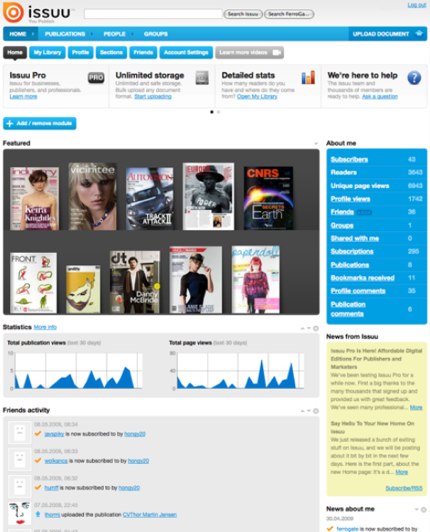 The site has also launched a collaborative Groups feature, where people can collect and discuss publications related to any topic. Anyone can quickly set up a group, style it and then invite friends. You can add publications and/or discussions directly, or by bookmarking a publication while reading it. Groups can be private or public, and about any topic you choose. For example, I found a group called “Travel the World,” which included travel guides. 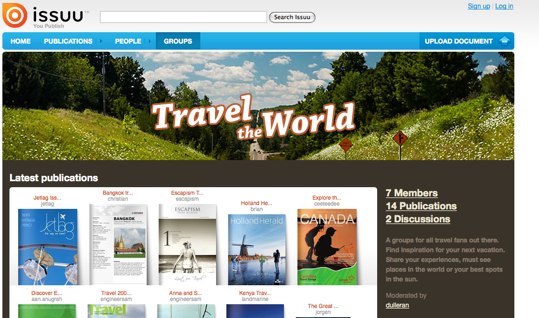 Issue has enhanced embedding by adding customization and multiple view modes (magazine, presentation, text) and allows a full screen pop-up directly from the embed widget. Each widget now includes a Share menu (think YouTube), where users can share, embed, and explore without leaving the widget. And the site has added a Library feature, a user-friendly manager and publishing tool where you can edit, organize and publish/embed directly from the management platform. 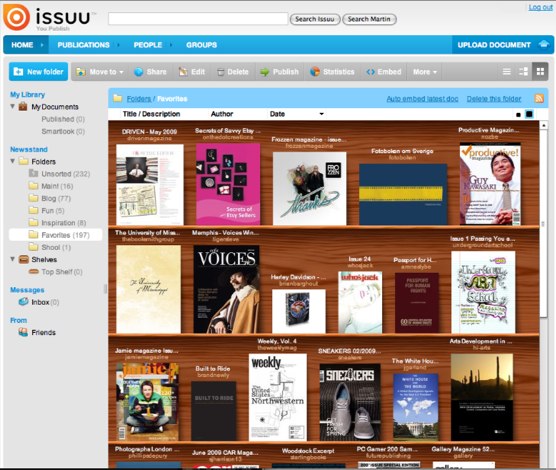 Document sharing services are finding a strong user base and are growing rapidly. Scribd, which also has a community-focus to its user interface, offers the ability to create and join groups. Like Issuu, Scribd has a free service and a premium service for enterprises. According to ComScore’s March numbers, Scribd definitely has the edge over both Issuu and Docstoc, bringing in 12 million unique visitors worldwide in March. Docstoc came in second with 2.89 million unique visitors in March, with Issuu coming in third with 2.4 million unique visitors. However, Issuu’s new interface and features are really visually compelling and easy to use. Scribd is the frontrunner in the race to be the most popular document sharing service, but Issuu and Docstoc keep adding innovative new features. Competition breeds innovation. Crunch Network: CrunchBoard because it’s time for you to find a new Job2.0 | ||||||||||||||
| Zeevex Debuts Virtual Currency For Online Games Posted: 12 May 2009 06:58 AM PDT
This is very similar to what PlaySpan is up to with its Ultimate Game Card. For more perspective on their product, read about their recent deal with hi5 or their acquisition of Spare Change. According to the press release, the Zeevex Digital Lockers will include social network plug-ins (for Facebook, Twitter, MySpace and Bebo) so users can trade Zeev Tokens with anyone but also provide parental controls and support for micro-transactions as low as 5 cents. Zeevex recently closed an undisclosed, private round of funding and is led by Ron Williams (CEO), Dean Gebert (CMO) and Robert Sanders (CTO). While the company would not go into detail on the financing round, it did say its seed round valuation was seven figures and that they are considering a VC-backed Series A round this Summer.
Crunch Network: CrunchBoard because it’s time for you to find a new Job2.0 | ||||||||||||||
| Would You Pay A Journalist To Report The News You Want To Read? Posted: 12 May 2009 06:32 AM PDT
Because that’s exactly what Global For Me’s is trying to do. Here’s how it works: you suggest a story to be investigated on the GFM website, and donate personally or together with others until you have the necessary funds to effectively have the company find and hire a journalist for you to—and I’m quoting from the website here—”go to briefings, press conferences, request interviews or door stop reluctant interviewees on your behalf.” Examples given on the homepage include politicians and local authorities but also “celebrities” and “anybody else”. In my opinion, that sounds more like hiring a private detective, but maybe I’m missing something here. Could this model ever work? In theory, it doesn’t sound all that bad. Communities are formed around a given topic and its members, aided by peer pressure and the use of social networking services, jointly decide what exactly should be investigated, a reporter does his or her job and gets paid the standard rate for it, Global For Me keeps a commission and the audience gets the news and/or answers to certain questions it was longing for delivered right at their virtual doorsteps. Everyone wins, right? In practice though, I’m not convinced it will work. The service would have to receive a heap of traction before the model gets even remotely viable enough for the journalists who would take on work through the service as well as for Global For Me. I’m also inclined to believe people would fund certain investigations to have a reporter discover what they want to see discovered, and that more often than not the end result will not live up to their expectations. And since there’s isn’t a publisher / editor to act as gatekeeper, who would they turn to to complain about possible bias or sloppy reporting? And looking at it from a different perspective, who’s to say freelance journalists - even if unvoluntarily - at some point wouldn’t start reporting stories the way the original commissioners (and the ones paying the bill) would want to see them reported? It’s worth noting that there are other organizations providing this type of service, but like Spot.us - perhaps the most familiar example of an online marketplace for community-funded reporting - they are non-profits and are not looking to commercialize the whole thing like GFM does. So let’s go back to the original question: would you consider paying a reporter to report a story on your behalf, and why (not)? Crunch Network: MobileCrunch Mobile Gadgets and Applications, Delivered Daily. | ||||||||||||||
| Facebook Remains Stubbornly Proud Of Position On Holocaust Denial Posted: 12 May 2009 02:00 AM PDT
While we don’t have much officially being said, we do have some Facebook employees speaking their mind directly, and most are pro-Holocaust deniers. Product Manager Ezra Callahan describes the posts by Brian Cuban and myself as “incomprehensible reasoning.” Ezra is not a Facebook spokesperson, but Randi Zuckerberg, who is a Facebook Spokesperson, says of Ezra’s note “Really well-written, articulate, and insightful note by Facebook employee Ezra Callahan on being a Jewish employee and supporting Facebook’s policy to not remove groups that deny the Holocaust.” That sounds like a stamp of approval to me. Ezra’s arguments in a nutshell: - Facebook is a “company run by a prominent Jew” and can’t “possibly show preferential treatment to one offended group over others” Here’s where I’m going to take a ninety degree turn. I’m not going to address these issues head on. Brian Cuban is doing that already, and provides logical counterpoints to these arguments. But I actually think even engaging in this debate is dangerous. The Holocaust is in its own special category of fucked up human behavior. Not because of the millions of Jews that were killed in the actual Holocaust - sadly that’s just how we roll as a race. No, the problem is that Holocaust deniers make their arguments for one simple purpose - they want to finish what was started and wipe Jews off the planet. We all know this is the elephant in the room, it’s just that the lawyers who write terms of service don’t really know how to deal with that. Nipples are bad, even if clearly not posted for sexual reasons. Holocaust denial is ok, even if clearly posted in order to spread hatred of Jews. That’s not something lawyers can tackle. I don’t make that statement lightly, nor do I expect everyone to agree. But in the last few days I’ve read a lot (a whole lot) of Holocaust denial literature on the Internet, and it is extremely scary stuff. The whole point of it is to suggest that Jews are engaged in a massive conspiracy to fool the world. These are the same types of conspiracy theories that led to the Holocaust in the first place. When you engage with Holocaust deniers to talk about where the lines are drawn you’ve already lost. Ezra and the rest of Facebook is playing the game on their terms. Holocaust denial is a seed. A seed that will grow into a fully bloomed second Holocaust if ever allowed to germinate. And Facebook is providing the fertile ground and watering needed to do just that. That’s why a dozen or so countries, all of which otherwise support free speech, have enacted laws against Holocaust denial. People love to hate, even smart people with significantly more than a “shred of common sense” as Ezra puts it. So many smart people think there is a Jewish conspiracy to rule the world. They can’t help but believe it. And giving those people a place on Facebook to share and expand those ideas is just too dangerous a thing to do. They know they can spread hatred of Jews if they stick mostly to just denying the Holocaust. And if a few members get out of hand every once in a while, they can just say that the group exists only to talk about whether the Holocaust happened or not, and certainly not to spread hate. See the images on my post from yesterday to see how these messages go. Sure, we can’t shut down the dark places on the Internet where people are free to hate Jews and post pictures of breast feeding mothers. But Facebook can take a stand and say it won’t happen in their back yard. Holocaust denial is hate speech, and it cannot be given a place to take root. This isn’t a slippery slope, Facebook. It’s evil. Pure evil. Don’t plant a flag on the wrong side of the line. Stand firm against racial and religious hatred, even if you don’t have to. You’ll look back in fifty years and be proud that you did. Because no matter what your terms of service say, this isn’t porn. It’s the Holocaust. And it happened.
Crunch Network: CrunchBase the free database of technology companies, people, and investors | ||||||||||||||
| Coming In June: ZuneHD … Or A Zune-Specific Phone? Posted: 12 May 2009 01:59 AM PDT
Right after that one, there was another cryptic one about Zune, of which I’m not entirely sure what it has to do with Office exactly. It read: “June 2009 will be an important month for Zune lovers”, and was followed by another one that asked some people who expressed interest on Twitter that it concerns a ‘new product launch’ and that they should ‘hold off from buying an iPhone or Palm Pre’. Neowin is considering this to be either a hint for a new (HD) version of Microsoft’s media player (which CrunchGear confirmed was coming this year) to be announced next month at E3 Expo, or the introduction of the much-rumored Zune Phone, a touch-screen multimedia cellphone Microsoft was reportedly working on together with Verizon. Fact is no one knows for sure what’s coming, but Microsoft has in the past made it abundantly clear that it wasn’t planning on entering the mobile device manufacturing market with a proprietary device, and that it wasn’t building a Zune-specific phone. That doesn’t necessarily mean it’s actually never going to happen, but I wouldn’t put any money on something like that being introduced next month. More likely, devices equipped with the latest versions of Windows Mobile will be extended with software that tightly integrates with Zune services (a project code-named ‘Pink’) although Microsoft could also plan the announcement of a major distribution partnership with carrier Verizon, despite rumors that the latter is also in talks with Apple for an iPhone contract when the current deal with AT&T expires. Or both. Or something else. Or maybe MS says June will be important for Zune just because it has a nice ring to it and they simply really don’t want you to buy a Pre or iPhone. Crunch Network: CrunchGear drool over the sexiest new gadgets and hardware. | ||||||||||||||
| Medialets’ Big Bet On The iPhone Pays Off With A $4 Million Round Posted: 12 May 2009 01:31 AM PDT
It was barely a month between the founding of the company and the launch of the App Store on July 11 of last year. But Medialets was there from day one. And thanks to that early start, the company’s offerings can now be found installed on nearly half of the iPhones and iPod touches out there in circulation. And their clients include many of the top downloaded apps. But the company clearly hopes the iPhone is just the beginning. With its new $4 million round led by Foundry Group, and participated in by DFJ Gotham and early Google investor Bobby Yazdani, the company is thinking expansion. It already has been on the Android platform as well since last September. But while that platform has thus far failed to ignite a new market the way the iPhone has, indications seem to point to 2009 being a good year for the platform with many more Android devices coming. The team has already secured over 1,000 developer partnerships between the iPhone and Android platforms. More importantly, Medialets is also looking to support BlackBerry, Windows Mobile, Symbian and Palm Pre in 2009. That would obviously put them on basically every major mobile platform. Medialets has a really nice looking offering it terms of its advertising platform (screenshot below), and Medialytics, its analytics offering, has proved me with some solid mobile data over the past few months (all anonymous of course). One nice thing about Medialytics, is that it can work whether a user is online or offline — something which is often the case with the WiFi-only iPod touch.
Crunch Network: CrunchBase the free database of technology companies, people, and investors | ||||||||||||||
| Brightcove Brings Its Ad-Supported Videos To Vudu Set-Top Boxes Posted: 11 May 2009 10:03 PM PDT
Of course, it’s just a matter of the right people to sign on the right dotted lines to get other Brightcove-supported sites and services onto the Vudu. Ad-supported content is being tentatively embraced by big media, which is almost certainly a good thing, and this is one of the first real forays into pushing it onto a set-top box. A year ago, I would have considered the idea of Sony letting me stream their content onto my TV for free a ridiculous notion, but here we are. Pleasant surprises are mighty rare in this sector. The battle for the top of the TV set (or in the closet nearby for wifi-enabled ones like the Vudu) is getting pretty heated, and major deals like this tip the balance of power significantly. Plus, it ends up being good for the consumer as they pack more and more into a box you already paid for. We’ve just got our one screenshot for now, but tomorrow we’ll try to put up some video so you can see how she handles. Crunch Network: CrunchGear drool over the sexiest new gadgets and hardware. | ||||||||||||||
| Google News Gets An Update. Still Sucks. Posted: 11 May 2009 07:52 PM PDT
Now, when you click on the “all XXXX news articles” link below each story cluster in Google News, you are taken to a page with a range of content. This includes not only major publication headlines, but blog headlines, picture thumbnails, a timeline of articles on the topic, and even quotes about the topic. The problem, as you can see in my screenshots below, is that Google cannot seem to cluster stories together correctly. If it sees a story is about say, a religious app being banned on the iPhone, it will cluster that with a story about iPhone ad data — even though the two are not the same story at all. Yet when you click to go to the new area, it indicates that they are the same story, as you can do things like “Search the story.” On any given day there are probably a dozen different stories about the iPhone (at least), and I guess it’d be fine (but silly) if Google wants to cluster them all together. But it doesn’t even do that. There are several clusters containing iPhone items. It seems to be just random which ones go where. The problem is that Google uses an algorithm to do this clustering. As the vastly superior news aggregator Techmeme, learned quite a while ago, there needs to be some human curation involved. While an algorithm may not be able to see the difference in iPhone stories (or Microsoft stories, or anything else in my example below for that matter), a human could. Further, the biggest problem with Google News when it comes to tech news is that many of the items that appear are laughably old. It’s fine if you want to say it’s for the masses to get a better overview of what’s going on, but at least indicate that these topics aren’t breaking items just because some site decided to write about it again a day or two days or a week after someone else published the story first. The timeline view kind of indicates the age of a story, but if you see it’s far from its peak, then don’t make it a top item on Google News. Almost all of the top items right now are far from their peaks. I could go on. Many of the headlines Google News chooses to use are complete nonsense and give readers absolutely no idea what a story is about. And the excerpts below the titles are often a gibberish mixture of author names, cities the story is based in and random links that don’t appear as links in the excerpts — giving you excepts like, “By Austin Modine Get more from this author Facebook has once again.” Brilliant. [photo: flickr/ang (3girls)] Crunch Network: CrunchBase the free database of technology companies, people, and investors | ||||||||||||||
| Facebook Payment Platform To Enter Testing Soon. Only 7 Months Late. Posted: 11 May 2009 06:56 PM PDT One of my longstanding gripes with Facebook Platform has been its lack of a unified payment platform that would offer developers a way to tie a Facebook-branded payment system into their apps. Back in March 2008, the company announced that one was coming in the “next 180 days”. That milestone came and went, and since then the company has been quiet about its current progress (we’re typically told things like “It’s not coming out any time soon”). But now it sounds like payments are finally starting to make some headway, reports Eric Eldon of VentureBeat, who writes that Facebook is set to begin testing a payment system with developers “in a few weeks”. We’ve independently confirmed that Facebook is indeed planning to test a payment platform, and that it will be a limited to a very small number of developers. The need for a payment platform may not be immediately obvious - after all, there are already quite a few ways for developers to accept payments through third party services like PayPal, and some companies are making quite a bit of money in the process. But for the end-user it is night and day. Users would only have to fill in their credit card information one time, and would also trust the platform more than they would a third party. The lowered barrier to entry would likely result in an increase in the number of transactions across many applications, as developers shifted their revenue models away from advertising (which has generally done poorly on Facebook) and into virtual goods and premium services. Facebook could potentially extend the platform to allow payments on other sites, too, though I suspect they’ll make sure its working on their home court before they take it elsewhere. Crunch Network: CrunchBoard because it’s time for you to find a new Job2.0 | ||||||||||||||
| Times Wire Gives You NYT In Real-Time. But The News May Be Old. Posted: 11 May 2009 06:47 PM PDT
Times Wire allows you to see New York Times articles, blog posts and stories by some wire services as they are placed on the web. It automatically updates every minute, placing the latest articles at the top of a stream of content in reverse chronological order. As an overview of the entire NYT site, it’s actually quite interesting. Looking at it right now, I’ve seen five new stories pop up in the past five minutes. But for the individual sections, such as technology, it’s pretty limited. The reason goes back to content. If I only focus on the technology feed in Times Wire, there have only been 5 new stories in the past 2 hours, so it’s not like you really need a live look at that feed. Further, while some are certainly interesting reads, none are particularly new, again negating the need for a live feed.
Business and Technology is actually one of the sections that has its own tab right now, as the NYT clearly knows that tech lovers will probably be more interested in this than the average reader — at least right now. For all other sections, you can use the “Your News” area to filter the various sections of the site into your wire feed. There are also photos featured on the right hand side of the site, that you can click on to go to the story they pertain to. And there is a RSS feed for the Times Wire, which is a nice touch — though the speed at which RSS travels to various readers will again likely negate any real-time bonus you would get if you kept the main Times Wire page open. Times Wire is the first NYT product built using the Times Newswire API, which the organization developed to give other sites access not only to its content, but to some of the interesting data it collects as well. Beginning tomorrow, Times Wire will be available on the homepage of the New York Times. For now, you can find it in action here. Overall, it definitely seems like a step in the right direction for the organization, as real-time is a hot trend right now. And it’s useful as a live overview of the entire site. But for people only interested in certain topics, it’s probably fine to stick with RSS because the real-time river isn’t flowing fast enough to necessitate keeping the page open.
Crunch Network: CrunchBoard because it’s time for you to find a new Job2.0 | ||||||||||||||
| Babble Raises $1 Million For Hipster Parenting Site Posted: 11 May 2009 04:01 PM PDT  Babble, a magazine and parenting community site aimed at urban hipsters, has secured $1 million in Series A funding from Greycroft Partners. This round adds to the $2 million Babble raised earlier from Village Ventures in December of 2008. (This is an extension of that round at the same valuation) Spun off from sex and dating community Nerve Media, Babble takes a more modern view on parenting, aimed at a younger generation of parents who live in cities, equally share parenting duties (or at least make an effort) and use the internet to access information. It is the same demographic that the magazine Cookie is going after, except it tries to appeal to the Dads as well. Urbanbaby.com is also a site that appeals to urban dwellers and parents. Nerve Media is also gaining a new CEO. Founder Rufus Griscom is passing the baton to Sean Mills, former president of The Onion. In his seven years as president, Mills helped grow the Onion from 30 to 175 employees and developed and launched The Onion News Network. Prior to The Onion, Mills founded and was managing director of ad agency Adgile Interactive in San Francisco and sold the company’s proprietary technology to Doubleclick in 2001. Crunch Network: MobileCrunch Mobile Gadgets and Applications, Delivered Daily. | ||||||||||||||
| Playboy Losing Its Pants, Intends To Save Print Business By Increasing Prices Posted: 11 May 2009 03:32 PM PDT
During an earnings call earlier today, Playboy Enterprises‘ interim CEO Jerome Kern (who replaced Hugh Hefner’s daughter Christie after she stepped down last December) didn’t really have any uplifting news to share. The publishing company reported a $13.7 million net loss during the first quarter of 2009, more than 3 times the loss it took during the same period in 2008 ($4.2 million). Athough, we should note Kern indicated that the loss includes $8.7 million of “impairment and restructuring charges”. In October 2008, Playboy laid off over a quarter of its workforce, axed its DVD business and its New York office and consequently merged its print and online operations to reduce costs significantly. “These initiatives allowed us to offset all but $1.4 million of the nearly $17 million revenue decline and led to improved margins in our TV and digital businesses, despite a lower revenue base,” said Kern. Lower revenue base, indeed. Revenues went down a whopping 26 percent compared to the same period in 2008, with digital revenue dropping to a lousy $9.3 million, down from $15.2 million during the first quarter last year. This was in big part due to the fact that Playboy decided to outsource its e-commerce operations. Domestic print didn’t perform all that well either, with reported revenue falling back to $13.5 million (down from $16.5 million during the first quarter of 2008). Total revenues for the period were $61.8 million, down more than 20 percent from $78.5 million a year ago. The decline in revenues for Playboy is significant, and like so many others companies it is really struggling in this economy on all fronts of its business, and its publishing segment in particular. Fortunately, Playboy’s interim CEO has a brilliant game plan to save the print business from fading away: From Folio:
That’s right, people! Fewer and fewer subscribers are opening Playboy’s magazines, and companies buying ad pages barely make up for the mere cost of printing and distributing them, but they’ve finally found the perfect solution to all their problems: charging more for fewer issues. Looking ahead, the company said it expects to report a 39% decline in magazine ad revenues in the second quarter compared to last year. Anyone ever seen Blackadder? I think this memorable quote from an episode of the fourth season of that great TV series captivates my thoughts on this: “If nothing else works, a total pig-headed unwillingness to look facts in the face will see us through.” Ten bucks says Playboy magazine doesn’t last as a standalone business. Crunch Network: CrunchGear drool over the sexiest new gadgets and hardware. | ||||||||||||||
| Google Is Greener Than Thou: One Newspaper Equals 850 Searches In CO2 Emissions Posted: 11 May 2009 03:13 PM PDT
Google can’t help itself. It just loves to brag about how green it is, even though its data centers use up a tremendous amount of energy. Still, on a per-search basis, it is less polluting than many alternatives - a fact it likes to remind us of, especially since it was accused of being an energy hog last January. In a greener-than-thou blog post touting how energy efficient its data centers are compared to the industry norm, Google points out that it takes 850 searches to emit the same amount of CO2 as it does to produce and distribute one newspaper. I wonder which activity produces the most information. And here I thought Google was trying to make nice with the newspaper industry. I can’t wait for a Google executive to bring up this factoid at the next Congressional hearing questioning whether Google is responsible for the demise of the newspaper industry. See, newspapers are dirty, practically evil. How do we know? Some Google engineers figured out the Co2 emissions comparisons on their computers. Cheeseburgers are even worse than newspapers. One cheeseburger emits as much CO2 as 15,000 searches. Maybe someone should send this data over to Christine Varney at the Department of Justice. Here are a few other comparisons:
(Photo credit: Flickr/Lee Jordan) Crunch Network: CrunchBoard because it’s time for you to find a new Job2.0 | ||||||||||||||
| Ten Free Tickets to Google I/O Developer Event Posted: 11 May 2009 03:10 PM PDT  Google has given us 10 free tickets for TechCrunchIT readers to attend for the upcoming Google I/O developer event on May 27-28 in San Francisco. Google I/O will be held at the Moscone Center and will cover the following topics: the Android, App Engine, Chrome, GWT, and AJAX APIs, with a special focus on the enterprise. Last year's event saw one of the first demonstrations of Google's Android mobile phone OS, as well as the public launch of App Engine. Google also handed out T-shirts cleverly meant to spell out "Google IO" in binary, except they actually said Google KO. Tickets are usually $400 each; but we are giving ten free tickets away to readers who give us the best answer to this question: Google has given us 10 free tickets for TechCrunchIT readers to attend for the upcoming Google I/O developer event on May 27-28 in San Francisco. Google I/O will be held at the Moscone Center and will cover the following topics: the Android, App Engine, Chrome, GWT, and AJAX APIs, with a special focus on the enterprise. Last year's event saw one of the first demonstrations of Google's Android mobile phone OS, as well as the public launch of App Engine. Google also handed out T-shirts cleverly meant to spell out "Google IO" in binary, except they actually said Google KO. Tickets are usually $400 each; but we are giving ten free tickets away to readers who give us the best answer to this question: Does Google have a real-time strategy and if so, how is it going to compete against Twitter and Facebook in the real-time wars given the recent death of RSS? | ||||||||||||||
| Y Combinator’s ReMail Finally Brings Full-Text Email Search To The iPhone Posted: 11 May 2009 02:21 PM PDT
Today, these problems are solved: a new Y Combinator startup called ReMail has just released its application on the App Store, and it’s bringing full text Email search to the iPhone. The application is currently free during its Beta period, and you can grab it here. Now, I know the first response people will have is that the upcoming iPhone 3.0 update is going to include Email search as part of the new Spotlight feature. This is mostly true - 3.0 will allow you to search through Email headers, which include the message’s subject line and its ‘To’ and ‘From’ fields. But that’s only half the battle. Spotlight omits the actual Email message, which accounts for a sizable chunk of an Email’s content. So how is ReMail doing what Apple can’t? The company has built a server optimized for rapid Email search, which the iPhone client connects to and grabs results from in a few seconds. It works exactly as it should, offering suggestions as you type your query and presenting matches as threads so you can see the context that a result was found in. If you search for “Jason inbox”, it knows that you’re looking for a person named Jason in the folder “inbox”. While the application requires internet connectivity if you want to search through your whole inbox, for most queries you won’t need a connection. ReMail has built in smart caching that locally stores all messages from the last two weeks, as well as any messages you’ve previously searched for (people often search for the same messages multiple times to look up things like phone numbers).
My initial reaction to the app was that it was great, but that it seemed to have a short shelf life - couldn’t Apple just update the 3.0 firmware to include full-text search? But CEO Gabor Cselle says that the iPhone simply can’t handle it in its current form. Even if the phone had an index of your Email stored locally (which would be costly in storage space), Cselle says that the iPhone doesn’t have the processing power to quickly scan through multiple gigabytes of messages. ReMail was founded by Gabor Cselle, who completed his Master’s thesis on Organizing Email, worked on the Gmail team, and was also VP of Engineering at Xobni, which he left last year to pursue his own company. The company’s backers include Paul Buchheit and Sanjeev Singh, who built a little application called Gmail (they also co-founded FriendFeed). These guys know what they’re doing. But there are some caveats that may keep some people from using ReMail. There are a few UI quirks (it appears that the client doesn’t render HTML), and the maximum inbox size is 10,000 messages, which is smaller than some users would like. It would also be nice if the app could serve as a replacement to Apple’s mail application (you can forward and reply to messages in ReMail, but for some reason you can’t compose a new one). The biggest issue, though, is privacy. ReMail works by sucking in your messages from your IMAP server and hosting them on its own server, which is optimized for rapid searching. Cselle says that the server is secure and that all messages are encrypted, but acknowledges that ReMail does have access to your Email. The company vows never to access or read any of it, unless they are given written permission to do so in the case of a support issue. That may not be enough for some people, especially those who deal with confidential information on a regular basis, but for most people it probably isn’t a show-stopper. It’s also worth noting that the same issues are associated with many other startups that host your private data. The application will stay free throughout the ReMail Beta, with plans to switch to a $3.99/month subscription plan later on. Crunch Network: CrunchBoard because it’s time for you to find a new Job2.0 | ||||||||||||||
| MSN Video: Why Is This Klingon Holding A Dolphin? Posted: 11 May 2009 02:12 PM PDT
In honor of the latest Star Trek release, MSN Video has rolled out a Klingon version of its Star Trek video page. Klingon, of course, is the tongue spoken by the race of the same name in the fictional Star Trek universe. For those of you who aren’t Trekkies, Klingons are the warrior race and usually are portrayed as the enemy in the Star Trek series and movies. One notably hilarious (or sad, depending on your point of view) video shows a “Captain_Krankor,” or taHjaj wo,’ seen posing in random photos, including one where he is holding a dolphin. The Klingon imperial anthem serves as the soundtrack to a slideshow of Captain Krankor spottings here on Earth, many of them on a corporate campus that could easily be Microsoft’s. Does anyone know, do they speak Klingon in Redmond? 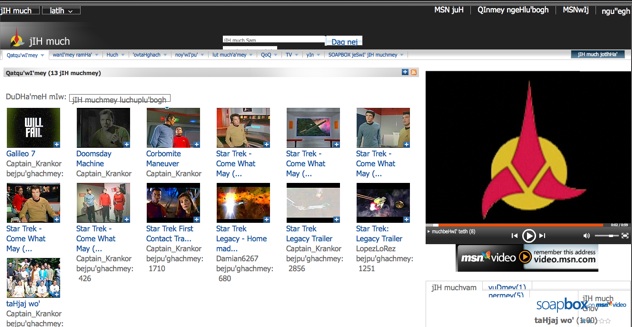 Crunch Network: MobileCrunch Mobile Gadgets and Applications, Delivered Daily. | ||||||||||||||
| Posted: 11 May 2009 01:00 PM PDT
Twitter is abuzz with angry complaints about FTD not delivering flowers to recipients on Mother’s Day. Apparently a number of Moms didn’t receive their FTD flowers even though the senders made the orders early in the week. Here are a few sample tweets about the FTD mishap:
We did a sentiment analysis of tweets about FTD’s brand using Twendz, which looks at the sentiments expressed about a brand or topic and measures how positive, neutral or negative the tweets are. According to Twendz, 63% of recent tweets about FTD are negative. And 83% of tweets that include “FTD” and “Mom” are negative. 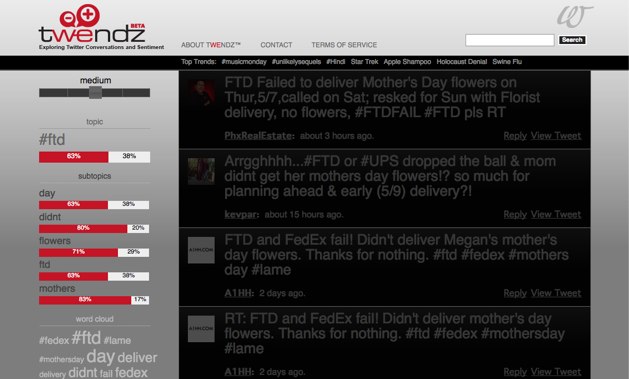 There is also negative buzz on Twitter about 1800Flowers.com regarding issues with the delivery of flowers yesterday. But interestingly, when you do a search on Twitter, you will see that 1800Flowers’ Twitter account is trying to appease customers. It’s not a bad idea, considering the damage that angry tweets can do for a brand. Twendz reports that only 33% of tweets about 1800Flowers.com are negative. FTD has twice the number of negative tweets. 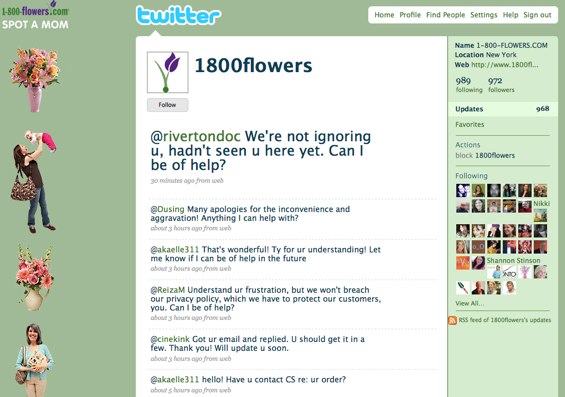 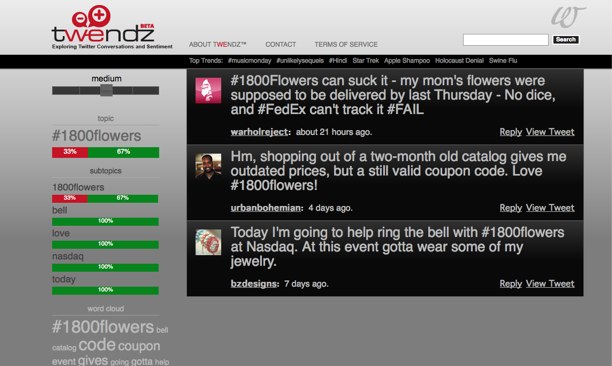 We’ve contacted both flower delivery services for comment but have not received a response. We understand that FTD sent those customers who were impacted an email offering a discount on their order. Here’s the text of the email:
Crunch Network: CrunchBoard because it’s time for you to find a new Job2.0 | ||||||||||||||
| Kindle iPhone App Draws Closer To Cutting Out The Kindle Middle Man Posted: 11 May 2009 11:48 AM PDT
Now, when you click on the “Get Books” icon in the iPhone app, you’re taken to a page that has a very iPhone-friendly Kindle book browser. From here you can search the over 280,000 Kindle books or browse by things like category, New York Times Best Sellers or books recommended for you. Unfortunately, clicking on any of these items kicks you out of the iPhone app and into Safari, where you actually do your surfing/purchasing (again, in this new iPhone-friendly look). That simply appears to be a limitation of the Kindle iPhone app itself (which wasn’t updated, just the look of the Kindle iPhone website was), and it seems likely that Amazon will correct that soon so you can browse and buy right from within the app. Such an update, along with the addition of the Stanza library of eBooks, would make the Kindle iPhone app a powerful one. It would also negate the desire of some people to actually go out and buy a Kindle, because the process would be just about as easy over an iPhone. Before everyone jumps on that, I realize the Kindle is a much better device for reading a book. I own a Kindle, it’s brilliant. But that doesn’t change two things: 1) It’s way too expensive (and the upcoming DX is even more ridiculously expensive) and 2) The Kindle itself is simply a hold-over device. What I mean by that is that the Kindle as a product is not going to survive. It simply doesn’t make sense to carry around another piece of hardware that is used for basically one small thing (reading eBooks). Instead, it makes sense to carry around either a tablet computer that also has this functionality, or something like the iPhone. Given the success we’re seeing of eBooks on the iPhone platform, it should be clear that despite the smaller screen that can be hard on the eyes, people are very open to the idea of reading content on it. And the iPhone screen will get better for reading books, and tablet computers/netbook will come along with the functionality. The Kindle as a device is simply not a long term play as it stands right now. But the Kindle as a store, is. And that’s what this seemingly small update to the Kindle web browsing interface on the iPhone is about. But there’s a very big twist coming down the road shortly. When the iPhone 3.0 software launches this summer, it will include the ability to do in-app purchases. You might think this would be a very obvious choice for Amazon to implement within the Kindle app to make purchasing even easier. But, with in-app purchases, Apple will be taking a 30% cut, just as it does for regular app purchases. You can bet that Amazon is not thrilled with that idea. I’d expect them to either try and cut some kind of better deal with Apple, or to stick with the web buying version. But would Apple be okay with that? And how does it’s rumored upcoming tablet device play into all this? Intrigue in the eBook world. Crunch Network: CrunchBoard because it’s time for you to find a new Job2.0 | ||||||||||||||
| Socialmedian Returns As Xing News Posted: 11 May 2009 11:40 AM PDT
At the time, I thought it was a bit of a strange move to support Facebook before powering the platform of its new owner, but former socialmedian CEO Jason Goldberg - who now has the position of Chief Product Officer at the public company - told me to expect an integration with XING to follow suite soon enough. As of today, XING users can install the first two applications on its OpenSocial-driven platform: one (Xing News) takes the entire concept of socialmedian - personalized news filtering and sharing - and transforms it into a straightforward XING feature, the other one (Ask Xing) is a tool users can install to easily ask questions to the XING community and get responses without ever needing to leave the service. These are arguably rather mundane applications, but the bigger news is that the social network now also features its very own application platform and is about to open it up to third-parties as well. In the near future, 10 current partners will get to distribute their own OpenSocial applications on the platform, and Goldberg tells me ultimately the plan is to open up more and finetune the approval process for new apps. For reference: XING boasts 7+ million members, mostly in Germany and neighbor countries, of which over half a million actually pay a monthly subscription fee to access some of the premium features.
Crunch Network: MobileCrunch Mobile Gadgets and Applications, Delivered Daily. | ||||||||||||||
| Apple Harpoons An iPhone App Due To Fail Whale Sighting Posted: 11 May 2009 10:56 AM PDT
Developer Kuan Yong, received the following letter from Apple letting him know about the rejection of his app, Tweetspotter:
Young also sent the picture Apple attached, and notes that the timestamp seems to prove that Apple was testing it when Twitter was still Fail Whaling big time after its planned maintenance on Friday. While on one hand, it’s kind of hard to blame Apple for a Twitter downtime that it’s almost for sure not paying attention to — on the other, it’s kind of lame that these app checkers only apparently check it one time during a day, and if the service it’s tied to is down, they reject it. Yong notes that the app works fine now, so no changes are needed but he’ll still have to resubmit the exact same app and wait another several days before its reviewed again. The moral of the story I suppose is to coordinate your app approvals with Twitter (or any other service) downtime. Twitter actually was supposed to have more maintance today, but postponed it. We hear they did so because of the NASA mission that was planning to tweet today. And while they didn’t give a reschedule date, we hear it may be Wednesday. So iPhone app developers working on Twitter apps, do not let Apple review your app this Wednesday. Unless you like headaches. Crunch Network: CrunchGear drool over the sexiest new gadgets and hardware. | ||||||||||||||
| SocialMedia Unveils New Interactive Ads, Scores IDG As Partner Posted: 11 May 2009 10:21 AM PDT
SocialMedia, an advertising company that has largely concentrated on social network advertising until now, is looking to change this. The company is releasing a suite of new interactive advertising products, collectively being called “People Powered Ads” that look to help brands create more engaging ads by tapping into the social power of the web. Alongside the launch the company has announced that publishing giant IDG is its first partner, and that IDG will be rolling out advertising campaigns and selling customized versions of ‘People Powered Ads’ under its own Amplify banner. The first set of People Power Ads revolves around Twitter - a platform that is at once very appealing and terrifying to most brands. The flagship ad unit is ‘Twitter Pulse’, which will display some of the most recent Tweets highlighting a company’s product or brand name (it’s essentially a custom emeddable Twitter Search). For example, Apple could create an ad unit for the iPhone, presenting the five most recent tweets that mention the popular device. This kind of ad can be quite engaging, but it is also scary for brands, as it could potentially display a tweet that is deriding the product. To compensate for this SocialMedia will allow brands to create their own filters to weed out profanity or negative remarks, or to only show tweets from selected users. SocialMedia is also offering a product called ‘Twitter MegaPulse’ that allows brands to create entire microsites dedicated to their customized feeds. And finally there’s ‘Twitter Sparq’, which allows brands to syndicate ads to Twitter clients, inviting users to tweet about a particular product (which would then likely show up in their Twitter Pulse). 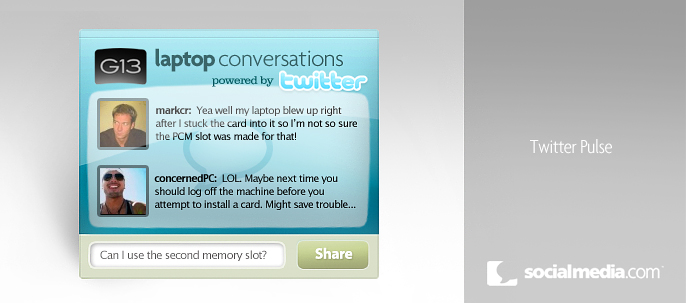 The second set of new ad units is called ‘Friend to Friend’. SocialMedia rolled out a similar product called “Word of Mouth” ads in March, inviting inviting users to interact with ads, which would then be customized with their responses when they were shown to friends. This product does essentially the same thing, but also allows brands to tap into content on their Facebook fan pages. And if a user grants SocialMedia permission though Facebook Connect, customized ads could appear on sites outside of the social network. Finally, there are community products, which aren’t reliant on any outside social networks. An ad unit called the ‘Community Poll’ asks users for input on a topic, and then presents the current results to other visitors. The last product is the ‘Community Stream’, which allows users to leave comments about a certain product or brand (it’s similar to the Twitter Pulse above, but allows visitors who don’t use Twitter to leave remarks.  It seems inevitable that the majority of online ads will eventually be customized to suit your personal preferences and those of your friends, and SocialMedia seems to be ahead of the curve in this respect. That said, even with the filter options it will likely still take many brands far longer than it should to warm up to the idea of ads customized with user-input, so it may still be a while before this becomes widespread. And while SocialMedia asks users for permission before sharing their input, I wouldn’t be surprised if there is also some initial backlash as users begin to see their friends pop up more often in ad units. Crunch Network: CrunchGear drool over the sexiest new gadgets and hardware. | ||||||||||||||
| NYT Launches TimeReader 2.0: Is It Time To Stop Killing Trees? Posted: 11 May 2009 10:20 AM PDT  There are two interesting things about the new New York Times Reader application. First, the company has abandoned SilverLight for Adobe Air, thereby ensuring cross-platform compatibility without that nasty Microsoft aftertaste. Second, the application is great. Full disclosure: I'm a regular contributor to the NYT but I'm not employed by them full-time and act as a freelancer. But I still read the paper every day. Now, for the good stuff. I used the earlier app briefly and put it away. I find that this new version is much cleaner than the earlier iteration. The front page is extremely readable and sections are clearly laid out. The application stores up to seven days of content and includes the crosswords as well as much of the standard print layout. You can't do a full, site-wide search through the app simply because that data isn't there. However, you can read the paper on a laptop. on a laptop. There are two interesting things about the new New York Times Reader application. First, the company has abandoned SilverLight for Adobe Air, thereby ensuring cross-platform compatibility without that nasty Microsoft aftertaste. Second, the application is great. Full disclosure: I'm a regular contributor to the NYT but I'm not employed by them full-time and act as a freelancer. But I still read the paper every day. Now, for the good stuff. I used the earlier app briefly and put it away. I find that this new version is much cleaner than the earlier iteration. The front page is extremely readable and sections are clearly laid out. The application stores up to seven days of content and includes the crosswords as well as much of the standard print layout. You can't do a full, site-wide search through the app simply because that data isn't there. However, you can read the paper on a laptop. on a laptop. | ||||||||||||||
| Watch Out Google, Obama’s Antitrust Chief Is Looking To Make An Example Out Of You Posted: 11 May 2009 10:11 AM PDT
The Obama Administration’s new chief antitrust enforcer at the Department of Justice, Christine Varney, is making it very clear that she is going to be much more aggressive in bringing antitrust actions against large, American corporations. The Bush Administration took a hands-off approach to antitrust enforcement, and that is about to change. Varney needs a high-profile case to make her name, and all indications are that she is eying Google. After all she needs to make an example out of a big powerful corporate “predator” and in this limping econmy there simply aren’t that many powerful companies to chose from. Google, quite literally, is the new Microsoft when it comes to antitrust scrutiny (although, Microsoft itself is also still under the magnifying glass, as is Intel, at least in Europe). Even under the Bush Justice Department, last year Google had to drop its advertising deal with Yahoo because of antitrust issues. Today, Google is dealing with an antitrust investigation over to its book-scanning settlement, the newspaper and magazine industries are rattling their sabers, and every other industry facing disruption by the internet is lining up to blame Google for their woes. Varney will be encouraging competitors of all potential antitrust targets to file more complaints, so you can be sure that anti-Google lobby will grow. Google makes a nice, juicy target and it is one of the few companies with cash on hand to pay a large fine. Google really needs to tread carefully now. It is effectively being treated as a monopoly because of its overwhelming dominance in paid search advertising, which gives it carte blanche to move into other markets with disruptive pricing models (i.e. free). There are many ways an antitrust case could be made against Google (here is one approach). While more scrutiny is not necessarily a bad thing if it serves to keep Google honest, especially in the areas where it is carving out a natural monopoly for itself in search and search advertising, tying up Google with antitrust lawsuits could do more harm than good. Any antitrust action should really be based on proven consumer harm or predatory pricing, not simply because Google is out-competing other companies. The problem with antitrust lawsuits, particularly in fast-moving industries such as technology, is they take so long to go through the courts that by the time a ruling is handed down the market has moved on (see Microsoft). The market will always do a better job undermining monopolies than the Justice department will. Varney would serve the country better looking at more entrenched industries such agriculture, health care or energy that could use some shaking up. In the technology industry, overturning the status quo is the only way to survive. Crunch Network: CrunchGear drool over the sexiest new gadgets and hardware. |
| You are subscribed to email updates from TechCrunch To stop receiving these emails, you may unsubscribe now. | Email delivery powered by Google |
| Inbox too full? | |
| If you prefer to unsubscribe via postal mail, write to: TechCrunch, c/o Google, 20 W Kinzie, Chicago IL USA 60610 | |
 There was a lot of buzz last week upon the announcement that
There was a lot of buzz last week upon the announcement that 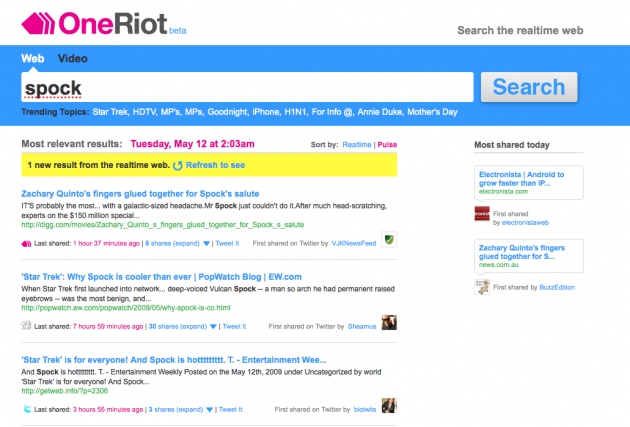
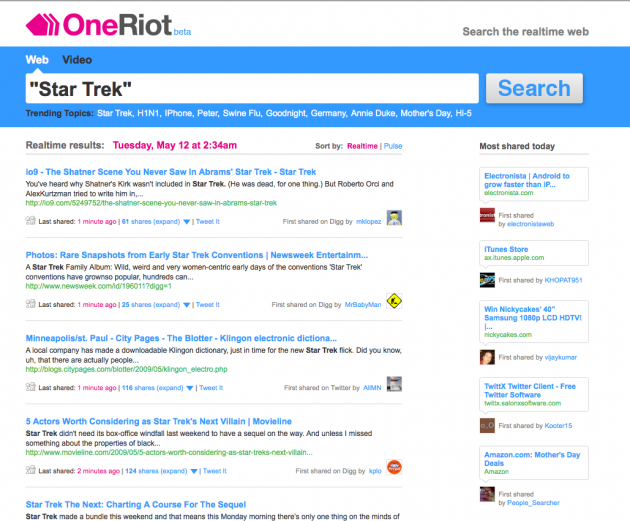


 Come July, Atlanta-based
Come July, Atlanta-based 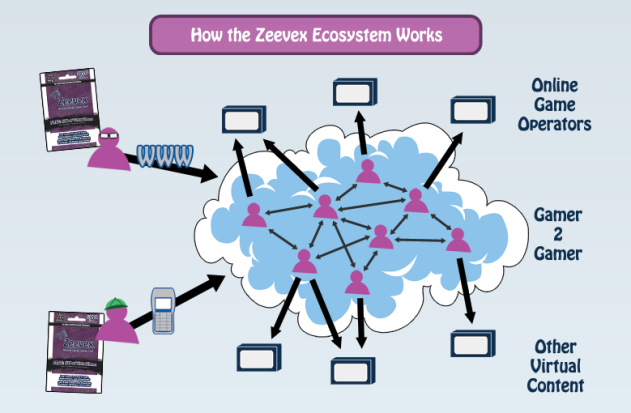
 I’m not asking if you would pay for press coverage as a business if it were possible. I’m asking if you would ever do it as an individual, when you think there’s something that’s been under-reported or even downright unreported to date and you want to see that situation changed. If you were looking for a story to be told that you consider to be missing from the news coverage already out there, would you be inclined to take out your wallet, and maybe even rally your friends, family and peers to do the same in order to be able to pay a reporter to do the fieldwork on your behalf?
I’m not asking if you would pay for press coverage as a business if it were possible. I’m asking if you would ever do it as an individual, when you think there’s something that’s been under-reported or even downright unreported to date and you want to see that situation changed. If you were looking for a story to be told that you consider to be missing from the news coverage already out there, would you be inclined to take out your wallet, and maybe even rally your friends, family and peers to do the same in order to be able to pay a reporter to do the fieldwork on your behalf?  Facebook is apparently done talking about Holocaust denial for now. A couple of groups that got more out of hand than the rest were taken down, but the company’s policy of permitting the groups on the site remains. “Denying the holocaust is not a violation of our terms,” says Facebook spokesperson Barry Schnitt in a comment to our
Facebook is apparently done talking about Holocaust denial for now. A couple of groups that got more out of hand than the rest were taken down, but the company’s policy of permitting the groups on the site remains. “Denying the holocaust is not a violation of our terms,” says Facebook spokesperson Barry Schnitt in a comment to our 
 So now Microsoft is happily seeding buzz through Twitter account
So now Microsoft is happily seeding buzz through Twitter account  When
When 

 I’m sorry, but for as good as Google is at organizing the world’s data,
I’m sorry, but for as good as Google is at organizing the world’s data, 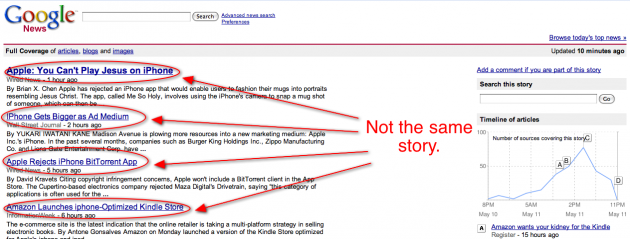
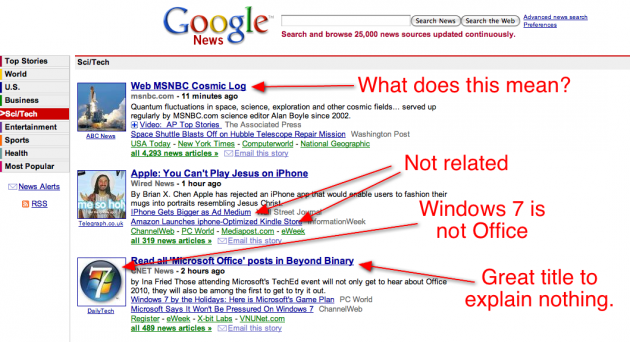

 One of the biggest knocks against traditional media isn’t necessarily that it’s not online — most of it is now — but rather that it’s slow when it comes to delivering news. By the time an old media site gets a story approved, written and edited, a dozen blogs probably have already covered the same news. That’s not always the case of course, and for those stories,
One of the biggest knocks against traditional media isn’t necessarily that it’s not online — most of it is now — but rather that it’s slow when it comes to delivering news. By the time an old media site gets a story approved, written and edited, a dozen blogs probably have already covered the same news. That’s not always the case of course, and for those stories, 
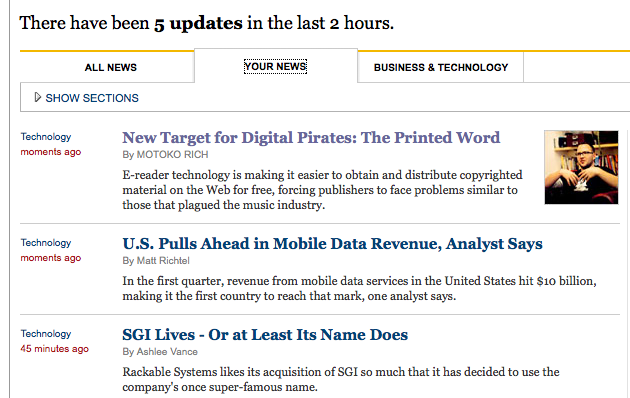
 The clock’s ticking for Playboy, folks.
The clock’s ticking for Playboy, folks. 



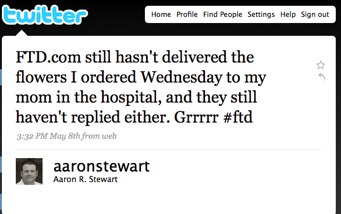
 Amazon releasing a Kindle iPhone app shortly after the introduction of the Kindle 2 was a brilliant move. It seemed to show that the emphasis was on the platform, not just one device. And that it was interested in making its customers happy. Unfortunately, to use the Kindle iPhone app, you still basically had to set your iPhone down and buy books on either your Kindle or the Amazon website. Sure, you could browse to it from the Safari browser on the iPhone, but the experience was laborious to say the least. Today, Amazon changed that a bit, and it may be an indication of where it’s going.
Amazon releasing a Kindle iPhone app shortly after the introduction of the Kindle 2 was a brilliant move. It seemed to show that the emphasis was on the platform, not just one device. And that it was interested in making its customers happy. Unfortunately, to use the Kindle iPhone app, you still basically had to set your iPhone down and buy books on either your Kindle or the Amazon website. Sure, you could browse to it from the Safari browser on the iPhone, but the experience was laborious to say the least. Today, Amazon changed that a bit, and it may be an indication of where it’s going. We recently covered
We recently covered 
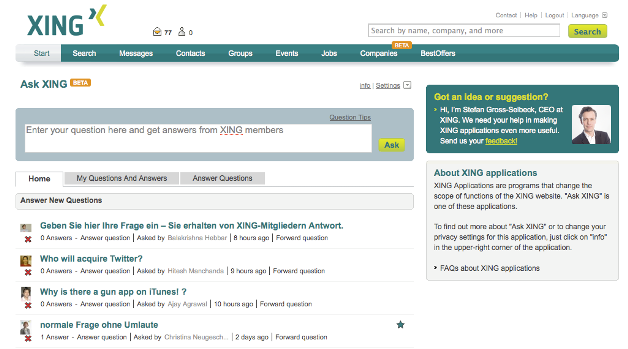
 Apple has a lot of silly reasons for rejecting iPhone apps, but Twitter seems to bring out some of the best of them. A few months ago, Apple
Apple has a lot of silly reasons for rejecting iPhone apps, but Twitter seems to bring out some of the best of them. A few months ago, Apple 

ReplyDeleteHello!
a debt of gratitude is in order for sharing this blog it's extremely useful to execute in our work.
Regards.
LANDSCAPE COMPANY IN JAIPUR